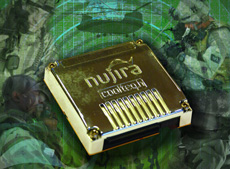- News
30 November 2010
Nujira’s first military PA platform halves power dissipation
 Nujira Ltd of Cambourne Business Park, Cambridge, UK has released its first power amplifier (PA) platform for military communications, halving the power dissipation for a transmitter covering an entire frequency octave. Such a transmitter can be built using just using just one PA together with a Coolteq power modulator module, the firm says.
Nujira Ltd of Cambourne Business Park, Cambridge, UK has released its first power amplifier (PA) platform for military communications, halving the power dissipation for a transmitter covering an entire frequency octave. Such a transmitter can be built using just using just one PA together with a Coolteq power modulator module, the firm says.
Picture: Nujira’s military PA platform, which helps reduce size and weight of batteries carried by troops.
“New military net-centric communications systems provide a secure rapid flow of voice, data and video information and offer reliable, good quality coverage over wide bandwidths,” says CEO Tim Haynes. “This transmission environment is especially challenging, as the required operating frequency range is very wide and the peak-to-average power ratio (PAPR) is high,” he adds. “Delivering such a major efficiency improvement is a significant achievement, and offers military communications systems designers and users a considerable advantage by reducing the size and weight of the batteries required and/or extending the usage time.”
The military PA platform uses Nujira’s Coolteq.h envelope tracking (ET) modulator module together with an RF3934 PA device made by RF Micro Devices Inc of Greensboro, NC, USA. The platform's performance was compared to the performance of the same transistor in fixed drain configuration over an operating frequency range of 225–450MHz, with signals with a very high PAPR of 10dB. Using the ET module, the amplifier showed an efficiency improvement from 25% to 40% (representing a halving of the power dissipation) and, as an additional benefit, delivered 1.5–2dB more peak power, Nujira claims.
The waveforms used in the new networked battlefield communications protocols are usually OFDM or QAM based and support frequency hopping and adaptive signal-to-noise encoding schemes. For example, the Wideband Networking Waveform (WNW) specified by JTRS for ground-to-ground and ground-to-air communications and the Tactical Targeting Network Technology (TTNT) used for airborne sensor, shooter and ordnance communication is based on the OFDM modulation scheme. The Soldier Radio Waveform (SRW) for soldier-to-soldier communications is based on QAM modulation. The MUOS (Mobile User Objective System) for satellite-to-ground, -sea or -air communication uses both OFDM and QAM, and leverages the W-CDMA technology developed commercially for existing mobile phone networks.
